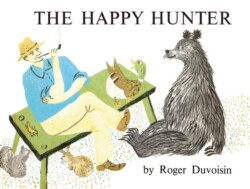The Happy Hunter
-
$13.56
The Happy Hunter
Hardcover
A man sits outside his cabin day after day, enjoying the beauty of nature and smoking on his pipe. “When the forest turned yellow he watched the hunters go by in their big yellow caps and big yellow coats, big black boots with yellow stockings, big brown belts with rows of cartridges, big shiny guns under their arms.”
He thought those men must be quite happy out hunting animals and wanted to be just like the hunters, looking big and bold in their hunting clothes. So, he went and bought his new look in hopes that he too would be happy. He soon learned that looking like a hunter and shooting animals wasn’t how he would be most happy.
Written in the 1960, The Happy Hunter won New York Time’s best-illustrated book in 1962. Author, Roger Duvoisin’s illustrations are antiquated in color, line, and texture. The dominate colors golden yellow and putrid green are less than desirable. However, a small amount of appeal is maintained in that the animals have pleasant faces.
The book has the potential to appeal to collectors of older picture books or even to students of children’s literature, comparing the illustrations and narrative of the past. This sends a message to readers that old doesn’t necessarily mean outdated or obsolete, but rather can provide valuable insight into the past and how to use the past in today’s books.
Criticisms of the book also revolve around its age. The hunter sits on his front porch smoking a pipe. A children’s book today would never feature a character smoking a pipe. There is also a sort of glorification placed upon the men who dress up to go shoot animals. This again wouldn’t sit well with animal rights’ activists or parents who may not like having to explain to a young child that some hunters kill for sport. The upside to the plot is that after the man has grown in years and many seasons have passed, he stops and looks at the hunting clothes and realizes that the image wasn’t ever what made him happy. What made him happy was being outside, surrounded by nature and all its splendor.
In the case of the hunter, getting a new look didn’t make him a better person, nor did it result in lasting happiness. Although a valuable moral, it doesn’t change the fact that this book may have been better left in the 1960s.
